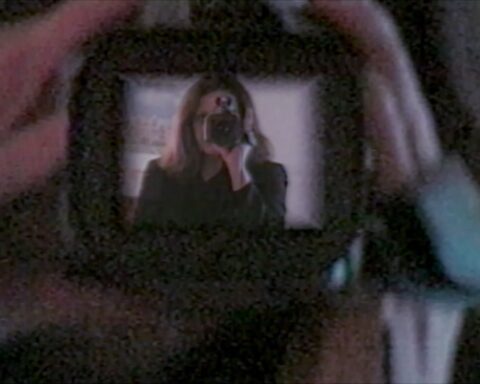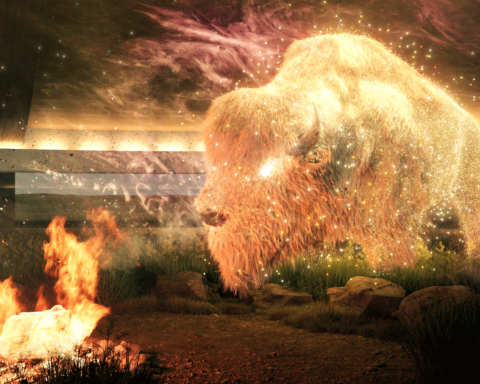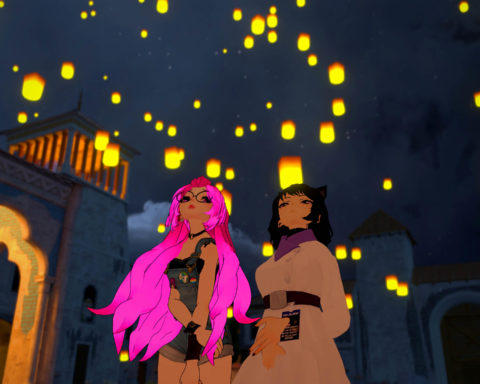“When Gregor Samsa woke up one morning from unsettling dreams, he found himself changed into a monstrous vermin.” – Franz Kafka, The Metamorphosis
This Halloween I went as Gregor Samsa, Kafka’s famous protagonist-turned-bug. The costume came courtesy of a MetamorphosisVR created by American-Czech artist Mika Johnson at Neuland, the showcase of immersive, virtual reality (VR) and augmented reality (AR) works at DOK Leipzig, Europe’s second largest festival for documentary and animation. I found myself in a small room in 1915 Prague, weighed down with a beetle-like backpack and equipped with VR gloves and slippers, ineptly trying to open a desk drawer with my newly grown insect arms. The attempt to offer a metaphorical space accessible only through one’s imagination worked disconcertingly well in the meticulously reconstituted Samsa house. The visit literally felt transformative – I jumped and gasped when I walked past a virtual mirror, at once disgusted and fascinated by the scales on my legs and the feelers on my head that I saw through my round bug eyes. After five minutes of trick-or-treating in the Samsa house, I wasn’t sure whether I wanted to move in or get out.
VRwandlung / MetamorphosisVR from Mika Johnson on Vimeo.
DOK Leipzig’s history of presenting hybrid, interactive, immersive, VR, and AR works and worlds has come a long way from setting up a handful of web-based and experimental projects in an igloo tent on Leipzig’s market square since 2015. This year’s 12-artist playground was spread out over two floors of a downtown office building and experienced by 3000 visitors.
When it comes to user experience, new media exhibitions assert themselves in two ways. Half the story is the presentation and the level of facilitation of the artworks; the other half is meaningful content, creative storytelling, high-quality artwork, and robust technical innovation. Visitors aren’t unceremoniously thrust into a staffer’s vacated office chair in Neuland, nor are they left alone to fight half-baked virtual infrastructures.
I encountered annoying technical limitations only twice in two hours at Neuland—not a bad ratio. DOK Neuland 2018 stood out among many immersive exhibitions I have seen internationally in terms of the thought and attention given to the big picture: What you see and hear when you enter; how you move alongside other visitors; how feelings ebb and flow through the space, from fairly heavy and ominous to luminous and playful and back; how each facilitator introduces the work with as much detail and direction as needed without giving away the mysteries, of which there were many. The works at DOK Neuland probed consciousness, blind spots, sensory and experiential multiplicities, offering up alternative or imaginary more-than-virtual realities – they were realities that aesthetically referenced expressionism, surrealism, or hyperrealism.
Reality is still part of and foil for VR, and so half of the dozen works were choreographed along a strip of slim black scaffolding, anchored in real life with plants while the windows were semi-blocked out with Kafkaesque tracing paper. “Freedom needs (gentle) framing,” is how Lars Rummel, DOK Neuland’s coordinator, summarized the viewer experience, reminiscent of a sonnet form. The DOK Neuland team put their hard work where their mouths were in the pre-festival announcement: “The overall festival motto ‘Demand the Impossible!’ serves as a guiding principle. We are transported to worlds that expand, defamiliarise, distort or temporally bend our present environment. DOK Neuland focuses on works that turn their users into explorers: not like Neo in The Matrix, but like Alice in Wonderland.”
The smart and site-specific choices by exhibition designer Paula Gehrmann enabled that journey without competing with the spaces you were about to enter through the works. “It was crucial for us that the exhibition space be clean as well as playful to keep it engaging – what I call ‘onion immersion,’ meaning that the more layers of immersive experience we offer the visitor, the more access points they have into the works,” said Rummel. “We’re (somewhat absurdly) extending what we know from our daily work routines with technology–swivelling chairs, the open-concept office, a reception area, the odd plant—into an interim moment, the non-space between man and machine.”
The wonderland provided room to concentrate on conceptually enigmatic and artistically billowing worlds. The experience ranged from the narrative to the associative, like the bespoke sound performance Der Dröhner, which placed users in a sensory deprivation tank only to co-create a dialogue with an improv musician (Karl Russell) droning and subwoofering users into a different mind-space. I can only imagine this bit is what a hypnotherapy session feels like.
Mental health issues loomed large throughout the exhibition. The first work I encountered, In My Absence by Dutch artist Niki Smit, visualises the effects of absence seizures, an affliction that has you black out for several seconds throughout the day. Sufferers narrated how they experienced these incidents, how they fill the voids, and how they re-imagine their visual lapses. Visitors literally stick their heads into three different VR scenarios to be enveloped by unfamiliar multi-sensory situations: What is it like to black out while in a car? How do you synchronise sound and non-image after a seizure? If you are not there, where are you? Like a number of other works in the exhibition–often at the intersection of science, media, and art– In My Absence lingered because its solid research base took users well beyond the mere technical effects and towards real-world human affect and empathy.
Sight, or lack thereof, was a recurring thread that inspired enhanced visual interpretations. One example came in the NFB’s enchanting if not groundbreaking fairy tale retelling Blind Vaysha by Theodore Ushev, based on Georgi Gospodinov’s short story that also inspired Ushev’s Oscar-nominated short animation. While Neuland’s work selection wasn’t strong on interactivity—I for one don’t mind since it often serves a token gesture that purports fake-agency—the pieces scored high when it came to artistic accomplishment (vs. gamey gimmicky-ness) and the intensity of immersion and transformation they offered. The pieces excelled by broadening and deepening the viewer’s cognitive, sensory, and imaginative realms and responses.
The Ukrainian-Danish co-production The Bridge stood out for the alluring artistry of watercoloured human shapes running through ghostly morphing landscapes while never arriving. It created a limitless, inescapable universe you could easily lose yourself in (and lose track of time in). As creator Nikita Shalenny poetically put it: “The idea of escaping is unconscious, it sprouts and becomes a young tree. Every morning I go to the yard with an axe and hack it at the root, banishing the wrong thoughts. The next morning it grows above me twice, its rustling leaves talking to the wind, which have already been everywhere.”
Visually stunning and glossy, at times dizzying, were two of the four 360° works. (The other two were more obviously made-for-TV.) The slick, quirky, and powerfully evocative Venice Biennale art piece Denoise by directorial team composer Giorgio Ferrero & DOP Federico Biasin was a geometric meditation on industrial production – think Werner Herzog & Ed Burtynsky on a slow-mo IMAX rollercoaster. The Real Thing, the tongue-in-cheek title of Mathias Chelebourg & Benoît Felici’s dislocating look at fake cities – Paris, Venice, and London recreated as Disneyworld-like tourist “destinations” in China — mashed original and imitation, real and virtual-in-virtual into a smart joyride of culture- and place-making. Both works were captivating because they were built like Russian nesting dolls: multi-layered, paradoxical, and bizarre, but rendered relatable through the films’ engrossing characters.
Nearly half of the Neuland works were Canadian productions, a clear bow to the country’s international avant-garde status in the field. “Canada seems to have a head start and an edge in knowledge when it comes to VR, partly due to its ambitious and progressive institutions,” observed Rummel. “Thus the works we see right now draw on a larger field of experience, are often more intuitive and more coherently designed. Canada of course does not have a monopoly on strong VR and others are coming up behind them, but 2018 was an impressive year for Canadian works.”
A Canadian work also won the first DOK Neuland Award. Kalina Bertin accepted the honour for her Manic VR, another walk-a-mile-in-someone-else’s-shoes kind of work that succeeded in transcending and transposing one group’s experience, here sending the audience on a journey through the different phases of bipolar disorder. The piece was technically ambitious with 3D animation paired with psychedelic pigmentation effects and room-scale interaction. Manic VR turned your head upside down and inside out, a humbling glimpse at what manic depression must mean in a person’s life. Back in Toronto, I remembered the piece again when I walked past my neighbour’s house, the home of a bipolar teen, realizing another kind of metamorphosis I had undergone at DOK Neuland, one of deeper understanding and “real” compassion for experiences outside my own and myself.











